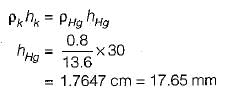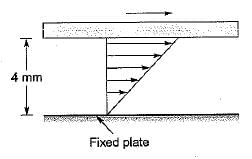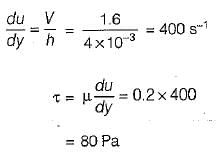Test: Properties of Fluids - 1 - Mechanical Engineering MCQ
10 Questions MCQ Test - Test: Properties of Fluids - 1
What is the equivalent pressure head of mercury corresponding to 30 cm column of kerosene of relative density 0.8?
What is dynamic viscosity in Pa-s for a liquid having relative density of 0.85 and kinematic viscosity of 2.5 centistoke?
The space between two parallel plates kept 4 mm apart is filled with an oil of dynamic viscosity 0.2 Pa-s. What is the shear stress on the lower fixed plate, if the upper one is moved with a velocity of 1.6 m/s? .
What is the pressure inside a soap bubble, over the atmospheric pressure if its diameter is 2 cm and the surface tension is 0.1 N/m?
The gap between a -horizontal shaft and a concentric sleeve is filled with viscous oil. The sleeve moves with a constant velocity of 1.5 m/s when a force of 1500 N is applied parallel to the axis of the shaft. If it was required to move the sleeve at a velocity of 2 m/s, what should have been the force?
The concept of continuum in fluid flow assumes that the characteristics length of the flow is
When a shear stress is applied to a substance, it is found to resist it by static deformation, the substance is:
The condition of ‘no slip’ at boundaries is applicable to:























